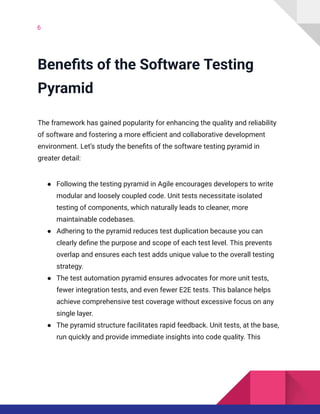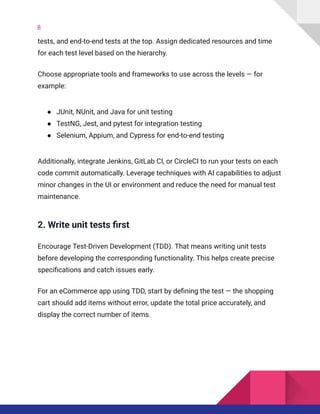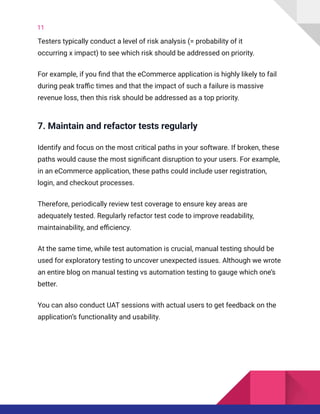Future of the Testing Pyramid: How AI and Codeless Tools Are Changing the Layers
- 2. 2 The testing pyramid is a conceptual framework that helps developers, testers, and quality analysts implement a series of tests, such as unit tests at the base, integration tests in the middle, and end-to-end tests at the top, to ensure a robust and reliable application. Introduced by Mike Cohn in his 2009 book Succeeding with Agile, the pyramid untangles the complexity of software testing by fitting it into an efficient hierarchical structure. It represents the logical progression and advancement of different fast, low-level, and comprehensive, high-level tests, enabling quicker iterations, improved code quality, and more stable product releases. If optimizing your software testing processes is one of your primary goals this year, dive into this article. Discover the structure, benefits, and critical role of the testing pyramid in modern software development. Plus, get actionable tips to integrate this framework into your workflows seamlessly.
- 3. 3 Understanding the Three Levels of the Test Pyramid Model The following layers represent how much testing will be performed — from bottom to top — in your test suite. 1. Unit tests Unit testing is the base of the software test pyramid. It focuses on individual components or smaller units of code within the software. It verifies that each part works correctly in isolation, without any dependencies on other system parts. Imagine you’re building an eCommerce application. One of its critical functions is calculating the total price of items in a shopping cart, including tax and discounts. For example, if a user adds a laptop, USB hub, and an external mouse to their cart, the function should compute the total price, apply a 10% tax, and subtract a $50 discount accurately. A unit test would verify the correctness of this calculation every time the function is executed. Research shows that 97% of businesses consider unit testing an extremely important part of their testing strategy. It helps them detect bugs in the initial
- 4. 4 stages of software development. Unit tests are run frequently. They’re typically numerous but quick to write and execute. 2. Integration tests Integration testing is performed after unit testing. Here, the interaction between different modules or services in the software is examined. It ensures that they work together as intended before they’re integrated with larger external software units to operate as a single entity. This test would focus on the interaction between the shopping cart and the payment gateway in the same eCommerce application. For example, when a user proceeds to checkout after adding items to their cart, integration testing ensures the system sends the order details to the payment gateway to process the payment correctly, and the user receives a confirmation. It streamlines the data flow between different internal and external components and appropriately handles any errors or discrepancies. Integration tests, fewer in number, are performed by testers once the development is complete. They’re more expensive and slow to execute. 3. End-to-end (E2E) tests
- 5. 5 E2E testing evaluates the software workflow by simulating user interactions with APIs, databases, and the interface, including form completion, button clicks, and navigation. Let’s take the same eCommerce application as an example. When a user visits the online platform, they first search for a laptop and browse the various available options. They select one product and add it to the cart based on their preference. After which, they proceed to checkout, enter shipping and payment details, and click on the button that says, “Place The Order.” The system processes the payment through the payment gateway, and the user receives an order confirmation message. E2E testing ensures that each step in this journey works correctly and that the user can successfully complete the purchase without any issues. These tests are few in number and require a fully deployed application environment. They’re run at critical milestones, such as before a release or after major features have been added to the application. E2E testing is the most complex to write and has the longest execution time.
- 6. 6 Benefits of the Software Testing Pyramid The framework has gained popularity for enhancing the quality and reliability of software and fostering a more efficient and collaborative development environment. Let’s study the benefits of the software testing pyramid in greater detail: ● Following the testing pyramid in Agile encourages developers to write modular and loosely coupled code. Unit tests necessitate isolated testing of components, which naturally leads to cleaner, more maintainable codebases. ● Adhering to the pyramid reduces test duplication because you can clearly define the purpose and scope of each test level. This prevents overlap and ensures each test adds unique value to the overall testing strategy. ● The test automation pyramid ensures advocates for more unit tests, fewer integration tests, and even fewer E2E tests. This balance helps achieve comprehensive test coverage without excessive focus on any single layer. ● The pyramid structure facilitates rapid feedback. Unit tests, at the base, run quickly and provide immediate insights into code quality. This
- 7. 7 prompt feedback loop helps catch defects early, minimizing the cascading effect of bugs. ● Maintaining a well-structured test suite is easier with the pyramid. Since most tests are unit tests, which are generally simpler and quicker to update, the overall maintenance effort becomes more predictable and manageable. ● Early detection of defects, primarily through unit and integration tests, significantly lowers the cost of fixing issues. Resolving bugs at the unit test level is cheaper and less time-consuming than addressing them during later stages of development or post-release. How to Implement the Testing Pyramid in Software Development There are simple steps to follow to integrate this framework at the time of building a software solution: 1. Develop a testing strategy Outlining the testing process and its life cycle is easy here. You have to perform tests at three levels: unit tests at the base, followed by integration
- 8. 8 tests, and end-to-end tests at the top. Assign dedicated resources and time for each test level based on the hierarchy. Choose appropriate tools and frameworks to use across the levels — for example: ● JUnit, NUnit, and Java for unit testing ● TestNG, Jest, and pytest for integration testing ● Selenium, Appium, and Cypress for end-to-end testing Additionally, integrate Jenkins, GitLab CI, or CircleCI to run your tests on each code commit automatically. Leverage techniques with AI capabilities to adjust minor changes in the UI or environment and reduce the need for manual test maintenance. 2. Write unit tests first Encourage Test-Driven Development (TDD). That means writing unit tests before developing the corresponding functionality. This helps create precise specifications and catch issues early. For an eCommerce app using TDD, start by defining the test — the shopping cart should add items without error, update the total price accurately, and display the correct number of items.
- 9. 9 Implement the feature so that it does exactly what you’ve defined. Finally, evaluate by adding an item to the cart, verifying the total price update, and checking the displayed item count. Adjust until the feature meets the expected requirements, ensuring a robust and well-tested implementation. 3. Expand to integration tests Determine the critical interactions between components that need to be tested. Use mocks and stubs to simulate external services, ensuring integration tests focus on internal interactions. For example, suppose you want to check the communication between the payment processing and order management systems. In that case, you can simulate the payment gateway and ensure that orders are correctly updated with payment statuses. Besides, integration tests can be added incrementally as new components and features are developed and/or added. Continuously update your test suite to reflect changes in the application as outdated tests can lead to false positives or negatives, negatively hampering your end results.
- 10. 10 4. Implement E2E tests sparingly Design E2E tests to cover your application’s essential user journeys and critical paths. Ensure such testing is stable and reliable — manage dependencies and avoid dynamic data that can cause test failures. Use tools like SonarQube to generate test coverage reports and identify areas lacking sufficient tests. 5. Define testing measurements and metrics Establish KPIs and success metrics for the software testing project. This is important not only for measuring the process’ efficiency and quality but also for meeting a common goal and language of communication among teams and stakeholders. Some standard testing metrics include defect density, mean time to failure, defect leakage, and test coverage. 6. List out the potential risks It’s great if everything goes well and your tests have positive outcomes. But in reality, risks do show up, and it’s essential to have clear plans to mitigate them.
- 11. 11 Testers typically conduct a level of risk analysis (= probability of it occurring x impact) to see which risk should be addressed on priority. For example, if you find that the eCommerce application is highly likely to fail during peak traffic times and that the impact of such a failure is massive revenue loss, then this risk should be addressed as a top priority. 7. Maintain and refactor tests regularly Identify and focus on the most critical paths in your software. If broken, these paths would cause the most significant disruption to your users. For example, in an eCommerce application, these paths could include user registration, login, and checkout processes. Therefore, periodically review test coverage to ensure key areas are adequately tested. Regularly refactor test code to improve readability, maintainability, and efficiency. At the same time, while test automation is crucial, manual testing should be used for exploratory testing to uncover unexpected issues. Although we wrote an entire blog on manual testing vs automation testing to gauge which one’s better. You can also conduct UAT sessions with actual users to get feedback on the application’s functionality and usability.
- 12. 12 8. Train the team and take feedback Provide training sessions and resources to educate developers, testers, and quality analysts on the importance and implementation of the testing pyramid. Foster a cooperative environment where everyone can work together to achieve high-quality software. Lastly, feedback loops should be established where insights from production issues and user feedback are integrated into the testing process to improve test coverage continuously. The testing pyramid provides a structure for correctly building software. But that doesn’t mean you work in silos. Follow the best practices for using the testing pyramid model: ● Always write clean test code. ● Avoid test duplication to boost test efficacy and save time. ● Identify what test cases to automate and the scope of the automated tests. ● Prioritize your tests based on risks, as it helps accelerate software testing. ● Put tests into your deployment pipeline to speed up product delivery.
- 13. 13 The Evolution of the Testing Pyramid in Modern Software Development Ever since the Agile testing pyramid entered the picture, it has pushed the boundaries of what testing means and how it is implemented. Traditionally, it focused heavily on manual testing and surface-level validation, often resulting in slower feedback loops and higher maintenance costs. The framework has adapted to accommodate new methodologies, tools, and technologies in the modern context. For example, AI-driven test generation and self-healing tests have transformed the pyramid structure by automating the creation and maintenance of test cases. This not only accelerates the testing process but also increases coverage and reliability. AI can also predict potential points of failure and suggest areas that require rigorous testing. This makes the pyramid more dynamic and responsive to the complexities of modern software systems.
- 14. 14 Additionally, automated testing integrated into Continuous Integration and Continuous Deployment (CI/CD) pipelines ensures that every code change is validated in real time. This minimizes the risk of defects making it to production and enables rapid feedback for developers. Looking ahead, the pyramid concept may shift towards a more fluid model, where the three tests become less defined and might overlap more, and the emphasis on each type of test varies based on the project’s specific needs and context. We can anticipate a greater emphasis on predictive analytics, where AI models analyze historical data to foresee and prevent potential defects before they arise.
- 15. 15 Conclusion The testing pyramid remains a foundational concept in modern software development, offering a strategic framework for balancing speed, quality, and efficiency across various types of tests. By organizing tests into a structured hierarchy — unit at the base, integration in the middle, and end-to-end at the top — teams can achieve faster feedback, reduce costs, and build more reliable applications. As development practices evolve, so does the pyramid. From the integration of AI-powered test automation to tighter alignment with CI/CD pipelines, the model is becoming more adaptive and intelligent. However, its core principle remains unchanged: prioritize small, fast, and reliable tests while maintaining thoughtful coverage of higher-level user workflows. To fully harness its potential, teams must treat the pyramid as more than a static structure. Instead, it should be part of a continuous improvement cycle — refined by metrics, informed by risks, and shaped by real user feedback. When implemented thoughtfully, the testing pyramid not only improves software quality but also drives agility, collaboration, and long-term product success. Source: For more details, readers may also refer to TestGrid.















